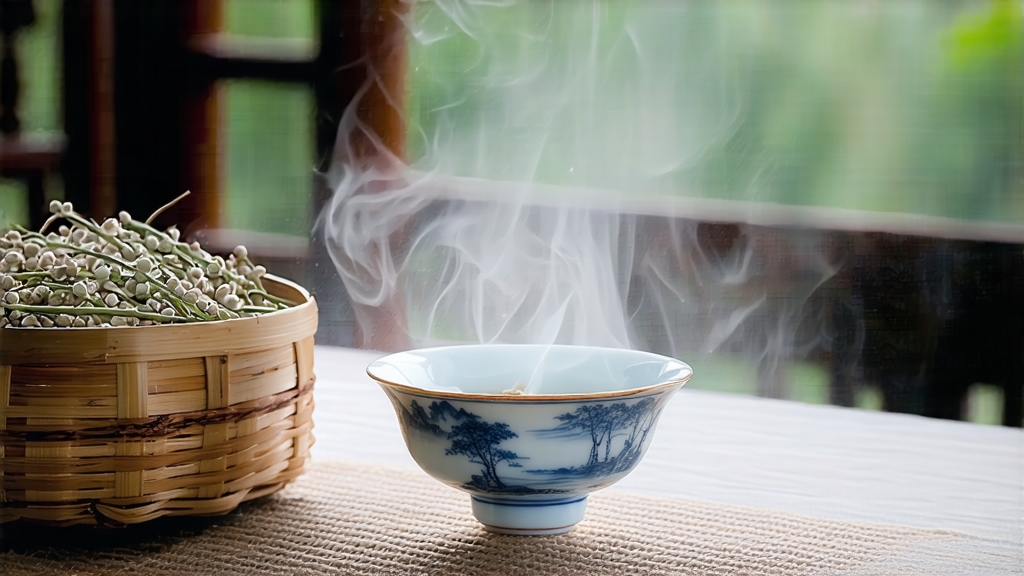
Among the six great families of Chinese tea, white tea is the least theatrical yet the most elusive, and within this quiet lineage Yin Zhen—known abroad as Silver Needle—stands like a moon-white brushstroke on indigo silk. First praised in the 1796 Daoguang-era gazette of Fuding County, Silver Needle was originally the tribute of scholars and merchants who wanted a tea that tasted of mountain mist and pear-blossom air. Legends say the name arose when a Qing magistrate, opening a lacquered caddy, saw the buds lying like slender acupuncture needles tipped with mercury-bright hairs; one glance convinced him that only the imperial court deserved such “needles of liquid light.”
Geography writes the first chapter of flavor. Authentic Silver Needle is born between 27° and 27°30′ north latitude, where the Wuyi Mountains descend toward the East China Sea. Here granitic soils drain quickly, forcing the tea bushes—predominantly Fuding Da Bai and Fuding Da Hao cultivars—to send their sugars into the terminal bud. Sea fog arrives each dawn, refracting ultraviolet light and thickening the epidermal hairs (bai hao) that protect the bud; the more down, the higher the amino acid L-theanine, hence the tea’s signature brothy sweetness. Altitude matters too: gardens at 400–700 m harvest seven days later than valley plots, but the extra chill slows oxidation enzymes, giving mountain Needle a cooler, cucumber-water note that lingers like a distant temple bell.
Plucking is brutally selective. Only the unopened bud, still sheathed in its first two infant leaves, is taken, and only on days when air humidity hovers between 65 % and 75 %. Experienced pickers use a “twist-lift” motion that snaps the stem without bruising; a single kilo of finished tea demands roughly 30,000 buds, all picked before ten o’clock so that morning dew acts as a natural antioxidant rinse. Because mechanical harvesters cannot discriminate down to the millimeter, every Silver Needle you meet has passed through human fingertips, making it one of the last truly hand-crafted commodities on earth.
Withering is where white tea becomes alchemy rather than agriculture. Traditionally the buds are laid on bamboo trays called shai qing, stacked in dragon-bone racks inside a sun-warmed corridor. For the first twelve hours they rest in shade while enzymatic hydrolysis converts proteins into free amino acids; the next twelve hours they are moved into filtered sunlight (26–28 °C) to initiate non-enzymatic browning. Master tea makers read the leaf like a manuscript: when the bud’s spine kinks without snapping and the down turns from silver to pewter, the tea is “green-killed” by nothing more than a cool breeze. Modern factories mimic this cycle with climate chambers, but connoisseurs swear the old way leaves a faint “rice-porridge” note impossible to replicate under LED lights.
No rolling, no pan-firing, no shaking—Silver Needle’s restraint is its strength. Once withered to 8–10 % moisture, the buds are baked at 40 °C for twenty minutes, just enough to drop water activity below 0.3 and lock in the hay-like aroma of coumarin. The final tea contains roughly 3.5 % caffeine, 6 % catechins, and an extraordinary 5.5 % theanine, a ratio that delivers calm alertness without the jittery spike of green tea. Because oxidation is halted so gently, Silver Needle continues to age; cakes pressed in the 1990s now steep apricot-colored liquor tasting of dried longan and beeswax, a living argument that white tea can evolve as nobly as pu-erh.
To brew Silver Needle is to negotiate with subtlety. Begin with a tall glass or a thin-walled gaiwan so the buds stand upright like miniature lighthouse beacons. Use 3 g for 120 ml, water at 85 °C—any hotter volatilizes the downy hairs into a scummy film, any cooler fails to coax out the creamy middle notes. First infusion: 45 seconds, pouring slowly down the vessel wall to avoid “shocking” the bud; liquor should be the color of pale chardonnay with a rim of green jade. Second infusion: 30 seconds, aroma shifts from wet bamboo to honeydew. Third infusion: 50 seconds, the cup offers a fleeting scent